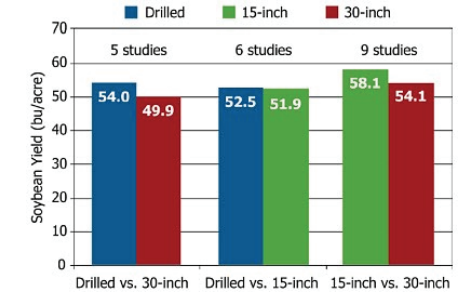ILSOYADVISOR POST
What You Should Know About Your Soybean Row
Article originally posted on the Burrus Buzz.
Recently, both agronomists and growers have been circling around the question of soybean row width and during a recent Twitter poll, 37% voted for me to write about soybean row spacing. This soybean management strategy has been pondered for almost 80 years. I could go on forever citing research, but the conclusion is greater yield potential has been achieved with row spacing less than 30 inches.
Don’t get me wrong, there are many that have not adopted narrow row soybeans because of economic factors which can outweigh higher yield potential such as: equipment cost, workload, wheel track damage, residue, disease, or weed cultivation. In all fairness, narrow row spacings have litle to no yield advantage in stressful growing conditions including soybean cyst nematode, white mold, brown stem rot, sudden death syndrome, or a lack of moisture/nitrogen. Therefore, there is no “one size fits all approach” when it comes to row spacing and there is still a significant amount of soybean acres planted in 30-inch rows.
Besides weed control, harvestability, and fertilizer placement, a main benefit of narrow rows is to capture as much sunlight as possible, which can be converted into biomass. Studies indicate soybeans need to attain 95% light interception by early reproductive growth to maximize yield which requires a leaf area index of 3.5 to 4.0. This concept especially holds true in shorter growing seasons (north), earlier maturity, delayed planting, and double-crop situations. However, multiple management practices encourage efficient light interception and conversion of radiation into higher yields such as: planting early (longer growing season), manage for a green or healthy canopy, manage for non-limitng fertlity, irrigation (rainfall), fuller maturity, seeding rates, and nitrogen at higher yield levels (>80 bu/a).
Average yield results from 10 soybean row spacing studies published during the last 15 years.
(Chart taken from https://www.pioneer.com/home/site/us/agronomy/soybean-row-width/)
Burrus Buzz
Delivering more than just seed
3.27.18
Stalk Us! www.burrusseed.com 1-877-4-BURRUS
Another question is which narrow row spacing is the best and perhaps we need more research. Over time, many have gone to a narrow, 15-inch row with a planter to capture yield benefit but seek a better seed placement/singulation capability compared to the drills of the past (controlled spill). However, research showed averaged yield results had only a minor yield difference when comparing 15-inch rows to those that were drilled (see chart on previous page). As for seed population, several studies have concluded narrow row systems do not require a greater harvest stand to maximize yield, so drop your seed population.
In conclusion, Archontoulis in Understanding 120-bushel soybeans said it best, “No single factor can predict and explain yield levels and variability. There are a lot of interactions, and you need a systems approach to understand the complex dynamics of growing soybeans.” In other words, a narrow row system is not the only management strategy required to achieve higher soybean yields. Dr. Below also describes a multiple system approach in his Six Secrets to Soybean Success, with narrow rows only being one secret and adds that narrow rows are more responsive to higher yields when adding more intensive management factors. As research continues, studies such as Sitiing and Winnowing: An Analysis of Farmer Field Data for Soybean in the US North Central Region make us wonder if management
strategies such as early planing and foliar protection are more consistently associated to soybean yield variations, rather than row spacing.





Comments
Add new comment